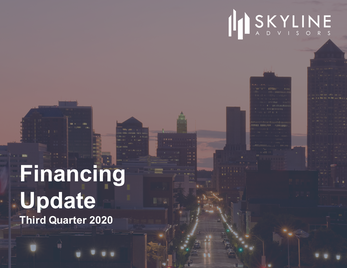 Download our Second Quarter 2021 M&A Update here. The year is shaping up to be a great year for M&A activity, as a number of factors – strong economic growth, record government spending and stimulus, low borrowing rates, and easing inflation worries – are leading to record deal-making. Deal volume during the quarter was approximately double the volume in the second quarter of 2020, and year-to-date volume is 20% higher than the year-to-date period of 2019. Though there are risks to continued growth, we believe the market will remain strong in the short-term. In addition to the reasons above, the stock market continues to touch new highs, and executives continue to be optimistic. Risks to economic growth include restrictions related to the ongoing COVID-19 pandemic, a resurfacing of inflationary concerns, and any changes to the Federal Reserve’s existing policies. According to preliminary data from PitchBook Data, there were 513 US mergers and acquisitions in November, accounting for approximately $57 billion in total consideration. As we noted in our October 2020 Highlights post, Bloomberg reported a substantial increase in M&A volume before the election; however, those deals were simply announcements and may take time to close.
 Supported by a more “open” economy and record fiscal stimulus, the economy rebounded sharply in the third quarter, and investing activity followed suit. The aggregate value of venture capital (VC) investment increased 11% year over year in the third quarter of 2020 to reach $38 billion. And we’re seeing similar trends in private equity (PE) with year-to-date investments trending 7% higher than the same periods of 2019.  Download our Third Quarter Mergers & Acquisitions Update US mergers and acquisitions (M&A) activity bounced back in the third quarter after a steep decline in the second quarter. During the quarter, an estimated 2,450 deals were completed, accounting for an estimated $344 billion. While still below pre-pandemic levels, these represented increases of 25% and 12%, respectively from the second quarter. However, on a regional basis, activity in the Midwest region reached the lowest quarterly levels in at least seven years.  The economy roared back in the third quarter, thanks to an “open” economy and record Government stimulus. Advanced estimates of the quarter’s GDP reached 33.1%, approximately twice the previous record. However, the output of the US economy still trails pre-pandemic levels, and there remains considerable uncertainty: Congress failed to pass additional stimulus in the third quarter and may not do so in 2020, and COVID-19 cases are reaching new highs that could cause more “closing” of the economy. Though deal volume was relatively unchanged in October, overall consideration spent on acquisitions ballooned during the month, climbing approximately 194% from September to $115 billion in October. Four deals amounted to over $10 billion: the acquisitions of TD Ameritrade ($22 billion), Immunomedics ($21 billion), E*Trade ($13 billion), and Noble Energy ($13 billion).
Sluggish merger and acquisition (M&A) activity carried over into September, as just over 500 transactions were completed in the US during the month.
Despite an apparent leveling off of deals (more September deals will certainly be reported as there is a lag in reporting), preliminary data from PitchBook suggests that overall transaction value climbed roughly 60% month over month. In the Midwest, 14 transactions were preliminarily reported, a slight increase from August’s 11 deals. Deals in the information technology space were favored, accounting for six of the 14 completed. Preliminary data from PitchBook suggests that August was a slow month for national and Midwest merger and acquisition (M&A) activity. In the US, fewer than 500 deals were completed during the month, a nearly 25% reversal of the recovery we began to see after May’s lows. Similarly, M&A activity in the Midwest fell to the lowest level of the year. However, the data may not be as dreary as a first glance shows – more than 150 deals were announced in the US during the month, estimated to account for over $110 billion in transaction value. Furthermore, the Midwest had one deal announced during the month that topped $1 billion – Waystar Health announced during the month that it would acquire Overland Park-based eSolutions for an estimated $1.35 billion.
 Download the Second Quarter 2020 Private Equity Update here. As the impact of the COVID-19 pandemic dragged into the second quarter, there was a noticeable effect on private equity deal-making. The volume of buyouts and exits (instances in which a private equity investor exits their investment) fell sharply with a 44% decline quarter over quarter, and fundraising was also off from 2019 highs.  In the second quarter, US venture capital investment was surprisingly consistent from previous quarters and actually topped the average over the last twelve quarters. This quarter we continued seeing the trend of fewer but larger deals, with volume in the second quarter falling 23% from the first to approximately 2,200 deals. However, overall value consideration during the quarter was $34.3 billion, a decline of only 4.5% from the first quarter but just a 1.3% from the quarter a year ago. This fewer-but-larger deal trend has progressed over the last five quarters now and signals that investors are more cautious with their funds but are simultaneous more willing to deploy capital into what they perceive to be high-quality companies with strong growth prospects. |
Archives
May 2023
Categories
All
|
|
Skyline Advisors is a division of Ideation Ventures, Inc. Services involving securities are offered through M&A Securities Group, Inc.4151 N Mulberry Drive Suite 252, Kansas City, MO, 64116 (“MAS") . Services involving real estate brokerage are offered through Berkshire Hathaway HomeServices Ambassador Real Estate ("BHHS"). Skyline, MAS, and BHHS are separate entities.
COPYRIGHT 2024. ALL RIGHTS RESERVED. |

 RSS Feed
RSS Feed
